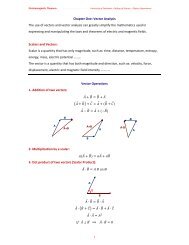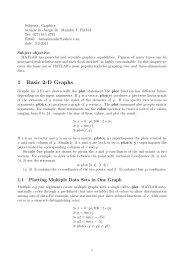Using Cumulative Count Of Conforming CCC-Chart to Study the ...
Using Cumulative Count Of Conforming CCC-Chart to Study the ...
Using Cumulative Count Of Conforming CCC-Chart to Study the ...
You also want an ePaper? Increase the reach of your titles
YUMPU automatically turns print PDFs into web optimized ePapers that Google loves.
2<br />
Cl =<br />
p<br />
And for np-chart, which is used for <strong>the</strong> moni<strong>to</strong>ring number of non-conforming items in<br />
samples of size n ,modified limits are as follows:.<br />
UCL, LCL = np ± 3 np(1<br />
− p)<br />
…2-3<br />
Cl = np<br />
When <strong>the</strong> sample size is fixed for all sample <strong>the</strong> p − chart and np − <strong>Chart</strong> are very<br />
similar and <strong>the</strong> different is only in <strong>the</strong> scale of <strong>the</strong> y-axis. Different p-charts can be easily<br />
compared as <strong>the</strong> center line for <strong>the</strong> process fraction nonconforming level .For np –<strong>Chart</strong><br />
<strong>the</strong> center line is affected by <strong>the</strong> sample size.<br />
When p or<br />
skewness of binomial distribution, <strong>the</strong> lower limit based on 3 sigma concept may not exist<br />
as it is usually a negative value, probability limit should be used when possible .On <strong>the</strong><br />
o<strong>the</strong>r hand, simple modification can be used <strong>to</strong> obtain better control limit for p<br />
or<br />
np − <strong>Chart</strong> .<br />
np − <strong>Chart</strong> are used it is important <strong>to</strong> use <strong>the</strong> appropriate limit, because of <strong>the</strong><br />
II- Modification <strong>Of</strong> Control <strong>Chart</strong><br />
Some improvement made on traditional p and np − <strong>Chart</strong> using some transformations<br />
so as <strong>to</strong> achieve high power in detecting np –words shift in a process, with a simple<br />
adjustments <strong>to</strong> <strong>the</strong> control limits of <strong>the</strong> p-chart one can achieve equal or even better results<br />
form of <strong>the</strong> available methods are as follows:<br />
3-1-Binomial Q chart:<br />
By transforming <strong>the</strong> binomial variable <strong>to</strong> standard normal variable, a Q-chart<br />
(Quesenberry 1997),could be drawn, with upper and lower control limits equal <strong>to</strong> 3 and -3<br />
respectively it is defined by:<br />
And<br />
u<br />
⎛ n ⎞<br />
i<br />
k n−k<br />
i<br />
= ∑ ⎜ ⎟p<br />
(1 − p)<br />
k = 0 p<br />
⎝<br />
⎠<br />
−1<br />
Q i<br />
= φ ( u i<br />
)<br />
−1<br />
Where (.)<br />
…3-1<br />
φ is <strong>the</strong> inverse function of <strong>the</strong> standard normal variable.<br />
Plotting φi<br />
s on <strong>the</strong> char, standard normal control chart with a uniform limit of (0 and 1)<br />
could be maintained.<br />
3-2- Arcsine p-chart<br />
This is ano<strong>the</strong>r nonlinear transformation like in <strong>the</strong> binomial Q chart with<br />
W<br />
i<br />
=<br />
⎡<br />
⎢<br />
⎢sin<br />
⎢<br />
⎢<br />
⎣<br />
⎛<br />
⎜<br />
⎜<br />
⎜<br />
⎜<br />
⎝<br />
3 ⎞<br />
x + ⎟<br />
8 ⎟ − sin<br />
3 ⎟<br />
ni<br />
+ ⎟<br />
8 ⎠<br />
⎤<br />
⎥<br />
⎥<br />
⎥<br />
⎥<br />
⎦<br />
( p )<br />
i<br />
−1<br />
−1<br />
2 ni<br />
…3-2
















